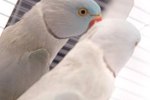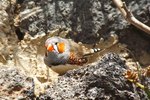Things You'll Need
2 by 4 inch lumber
1/4 by 1/4 inch mesh woven wire
1/2 by 1/2 inch mesh woven wire
Small fencing staples (U-shaped nails)
2 1-inch hinges
1 door latch
metal rods
Warnings
Disease can be a problem when birds are kept in close proximity, according to the University of Florida. Keep the cage areas as clean as possible and monitor the health of the flock.
Tips
Some states require a permit to raise game birds such as quail. Check local wildlife regulations before beginning any quail raising operation.
Quail is an increasingly popular, and increasingly scarce, menu item. For these reasons, more backyard poultry raisers have added bobwhite quail to their operations. The birds require special pen design and there are separate designs for breeding pairs and juveniles. Cage sizes in all cases are dependent on the number of birds to be housed in each cage. Breeding cages can house as few as two birds and up to five or six. Brooder cages are sized based on the number of quail young of each age group. Owners should determine their scale of operation before building pens.
Breeder Cages
Construct the cage framework. According to the Mississippi State University Extension Office, a breeding cage should provide two square feet for each bird. Breeding cages can be built for pairs of birds, or two or more females for each male. Construct the top and bottom cage framework out of 2 by 4 inch lumber around the perimeter of the cage. Use 3 inch galvanized deck screws to fasten the frame together at the corners. Cut 18 inch 2 by 4-inch boards for spacers between the top and bottom frameworks at the corners. Add a fifth support to serve as the frame of the door 10 inches from a corner. Fasten all the uprights in place using 3 inch galvanized deck screws.
Cover the floor of the cage with 1/4 by 1/4 inch mesh woven wire. Nail the wire in place using the small U-shaped nails commonly called fencing staples. Cover the sides and top of the cage using 1/2 by 1/2 inch mesh woven wire. Larger mesh wire can be used for breeder cages but if young birds will ever be placed in the cage, use the smaller mesh wire.
Build the frame of the door of 1 by 2 inch lumber to fit the opening created in the earlier steps. Cut four pieces of the 1 by 2 inch lumber to fit the perimeter of the door and assemble with 1 1/2 inch deck screws. Cover the door frame with same woven wire as the cage sides and top. Attach the cage door with two 1 inch hinges. Secure the door to the framework with a 1 inch latch.
Brooder Cages
Construct the cage framework for meat quail in a design identical to the breeder cages except on a larger scale. Cage space recommendations for birds vary with the age of the bird from 0.25 square feet for each bird under 6 weeks to 2 square feet per bird for near-mature birds. Birds kept for breeding stock need a minimum of 1 square foot per bird from 12 weeks until they are placed in the breeding pens. Estimate the number of birds in each brood or hatch and calculate the size of the brooder cages.
Add cross members under the floor for additional support. Use metal rods fastened between the 2 by 4 inch frame members. These supports keep the mesh floors from sagging due to the larger area of the floor and the heavier weight of multiple birds during the feeding process.
Build flight cages, cages big enough for young birds to learn to fly, if the birds will be released on hunting preserves. Use eight-foot posts set two feet into the ground at the corners of the flight cage. Place 2 by 4 inch boards around the perimeter at the top of the posts. Stretch woven 2 inch by 2 inch woven wire between the posts around the perimeter of the pen to the top of the posts. Stretch the same woven wire between the upper perimeter frame as a roof of the flight cage. This type of cage is built outdoors without a floor with the size variable depending on the number of birds.
References
Tips
- Some states require a permit to raise game birds such as quail. Check local wildlife regulations before beginning any quail raising operation.
Warnings
- Disease can be a problem when birds are kept in close proximity, according to the University of Florida. Keep the cage areas as clean as possible and monitor the health of the flock.
Photo Credits
-
Jupiterimages/Photos.com/Getty Images
Writer Bio
Keith Allen, a 1979 graduate of Valley City State College, has worked at a variety of jobs including computer operator, medical clinic manager, radio talk show host and potato sorter. For over five years he has worked as a newspaper reporter and historic researcher. His works have appeared in regional newspapers in North Dakota and in "North Dakota Horizons" and "Cowboys and Indians" magazines.





